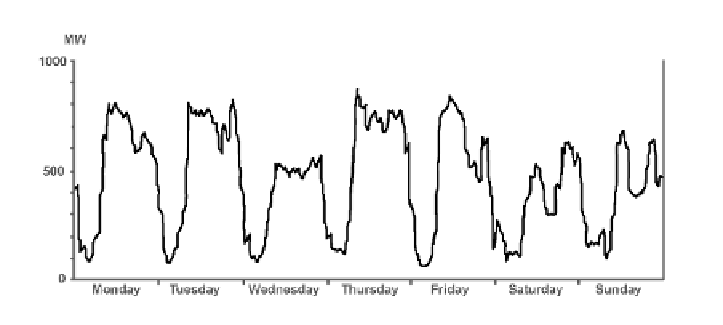Environmental Engineering Reference
In-Depth Information
Fig. 19.2.
Electricity generation (in megawatts (MW)) of the main hydropower company on
the Kemi River during one representative week in September 2007. The pattern shows a
stark increase of production in the morning and a sharp decrease during the night of each
day, generally with two peaks during each day before midday and in the late afternoon. Hy-
droelectricity generation on Saturday and Sunday is less than on usual weekdays (based on
Kemijoki Group 2008, p. 10)
In order to manage the river in this way, the power company regulates the dis-
charge from all the eighteen major hydroelectric plants every day around the
clock. Because the river's surface is frozen for about half a year and precipitation
falls as snow which accumulates on the land and on the ice instead of draining into
the river, its flow diminishes considerably over the year. Therefore, to continue
electricity production all year round - particularly in the cold and dark winter,
when demand is high - large reservoirs are filled over the summer and gradually
emptied over the winter (
Figure 19.3
). Because in lakes and reservoirs, only the
top layer is frozen over the winter, water can be easily extracted from underneath
this ice layer, even at temperatures far below the freezing point. Efficient hydroe-
lectricity generation seem thus to require both short- and long-term regulation,
through power plants and reservoirs respectively. Short-term regulation of the
river's flow enables the tuning of hydroelectricity production to electricity de-
mand; and long-term regulation of the watercourse attempts to adjust the seasonal-
ity of the river to the seasonality of electricity use. To be able to accomplish this
task, the engineers in charge have to know and continuously monitor the river very
well. For instance they have to be familiar with the amount of time that the water
takes to travel from one power station to the next. They can rely on a host of data
that is available in their company's control room, but at times some of them prefer
to obtain first-hand visual impressions and drive to various parts of the river to
take a look themselves.

Search WWH ::

Custom Search